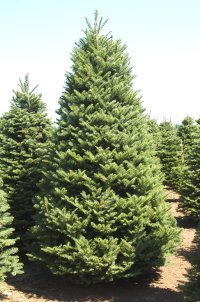 Last Christmas season, Clayton Valley Pumpkin Farm and Christmas Trees made a big to-do over a line of Willamette Valley-grown noble firs it was selling.
Last Christmas season, Clayton Valley Pumpkin Farm and Christmas Trees made a big to-do over a line of Willamette Valley-grown noble firs it was selling.

AURORA — Last Christmas season, Clayton Valley Pumpkin Farm and Christmas Trees made a big to-do over a line of Willamette Valley-grown noble firs it was selling.
The Northern California outlet held an exclusive showing of the trees, gave them their own display and played up their beauty, longevity, scarcity and Oregon upbringing. They charged 40% more for the select nobles — and in no time at all sold all 100 of its so-called designer Christmas trees.
“It’s one of the fastest sales I’ve ever had,” says David Osteen, Clayton Valley’s president, “and people are coming back in droves to reserve them for this year.”
Known as Oregon’s Noble Vintage, the stately firs — and the accompanying upscale marketing push — are a farm consortium’s response to the drooping sales, glutted market and increased faux fir competition facing Oregon’s Christmas tree growers.
“The industry’s been kind of stagnant,” says Tom McNabb, sales director for Yule Tree Farms, one of three Clackamas County growers involved in the program. “Nobody’s really putting any interest in what they’re doing, so we wanted to change that trend.”
The consortium debuted the ONV in 2004 and sold about 1,500 of the trees; it expects to sell about 4,000 this year.
Just about a dozen retailers nationwide, including one in the New York’s Hamptons, carry the ONV. They pay 15% more for the swanky trees, but the retail markup easily makes up for it. Osteen’s regular nobles sell for $89.95; the ONV’s go to a mostly upper-crust crowd for $134.
The ONV has at least helped generate some renewed interest from retailers and consumers — a good thing, considering that Oregon’s Christmas tree industry has been shedding needles lately.
Though still national champ for production, Oregon saw the value of its crop fall from $114 million in 2003 to $108 million last year, the result of too many trees and not enough buyers.
“It’s not that perfect sweet spot where supply and demand are really in line,” says Bryan Ostlund of the Pacific Northwest Christmas Tree Association.
McNabb says that while it’s important to keep the number of trees in check, another key component is to keep people engaged, thus the designer tree approach.
“If you’ve got more trees coming on, you’ve got to say, ‘Time to generate more interest,’” he says. “That’s why we started doing this — to generate interest and get people excited.”
— Jon Bell


